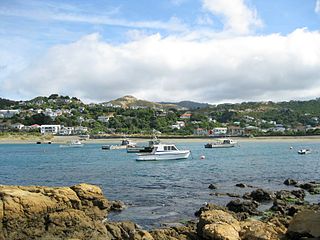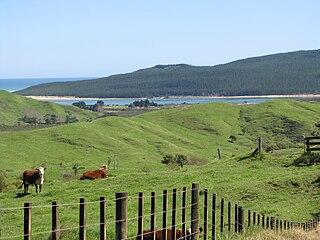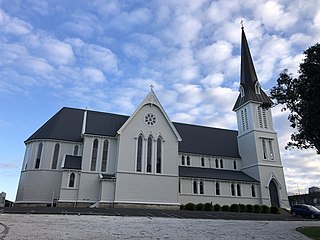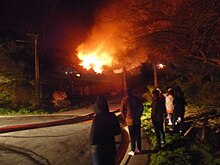
A marae, malaʻe, meʻae or malae is a communal or sacred place that serves religious and social purposes in Polynesian societies. In all these languages, the term also means cleared and free of weeds or trees. Marae generally consist of an area of cleared land roughly rectangular, bordered with stones or wooden posts perhaps with paepae (terraces) which were traditionally used for ceremonial purposes; and in some cases, such as Easter Island, a central stone ahu or a'u is placed. In the Easter Island Rapa Nui culture, the term ahu or a'u has become a synonym for the whole marae complex.

The Museum of New Zealand Te Papa Tongarewa is New Zealand's national museum and is located in Wellington. Usually known as Te Papa, it opened in 1998 after the merging of the National Museum of New Zealand and the National Art Gallery. An average of more than 1.5 million people visit every year, making it the 26th-most-visited art gallery in the world. Te Papa operates under a bicultural philosophy, and emphasises the living stories behind its cultural treasures.

Ōtaki is a town in the Kāpiti Coast District of the North Island of New Zealand, situated halfway between the capital city Wellington, 70 km (43 mi) to the southwest, and Palmerston North, 70 km (43 mi) to the northeast.

Island Bay is a coastal suburb of Wellington, the capital of New Zealand, situated 5 km (3.1 mi) south of the city centre.
Bruce Richard Stewart was a New Zealand fiction writer and dramatist of Ngāti Raukawa Te Arawa descent. Stewart's work often expresses the anger, the confused loyalties, and the spiritual aspirations of late-twentieth-century Māori. He set up a marae called Tapu Te Ranga in the 1970s in Island Bay in Wellington, and lived there until his death.

Ahipara is a town and locality in Northland, New Zealand at the southern end of Ninety Mile Beach, with the Tauroa Peninsula to the west and Herekino Forest to the east. Ahipara Bay is to the north west. Kaitaia is 14 km to the north east, and Pukepoto is between the two.

Te Rarawa is a Māori iwi of Northland, New Zealand. The iwi is one of five Muriwhenua iwi of the far north of the North Island.

Tikitiki is a small town in Waiapu Valley on the north bank of the Waiapu River in the Gisborne Region of the North Island of New Zealand. The area in which the town resides was formerly known as Kahukura. By road, Tikitiki is 145 km (90 mi) north-northeast of Gisborne, 20 km (12 mi) northeast by north of Ruatoria, and 24 km (15 mi) south by east of Te Araroa. The name of the town comes from the full name of Māui, Māui-tikitiki-a-Taranga. State Highway 35 passes through the town at the easternmost point of the New Zealand state highway network.

Clifford Hamilton Whiting was a New Zealand artist, teacher and advocate for Māori heritage.

Te Roopu Raranga Whatu o Aotearoa or Māori Weavers New Zealand is the New Zealand national Māori weavers’ collective, which aims to foster and preserve Māori traditional textiles. It has played an important role in facilitating the gathering of weavers of Māori and Pasifika descent to meet, teach and learn from one another.
Mitimiti is a small settlement in Northland, New Zealand. It lies close to the Warawara Forest, between the mouths of the Whangape Harbour and Hokianga Harbour on Northland's west coast, 44 km west of Kohukohu. Mitimiti is part of the Hokianga North statistical area. For demographics of this area, see Panguru.

Rongomaraeroa is the marae of the Museum of New Zealand Te Papa Tongarewa and incorporates a contemporary wharenuiTe Hono ki Hawaiki. It is located on the museum's 4th floor overlooking Wellington harbour, and was officially opened on 30 November 1997.

The Māori people and Moriori people have 773 tribal marae around New Zealand. These grounds usually include a wharenui and are usually affiliated with iwi (tribes) and hapū (sub-tribes).
Māori Indians are an ethnic group in New Zealand of people with mixed Māori and Indian ancestry.

The Church of the Holy Sepulchre, commonly known as Holy Sep and St Sepulchre's, is an historic Anglican church located on Khyber Pass Road, Grafton, near the central business district of Auckland, New Zealand. The church and wider marae complex are also known as.
Taki Rua is a theatre organisation based in Wellington, New Zealand that has produced many contemporary Māori theatre productions. Taki Rua has been going since 1983 and has had several name changes over that time including The New Depot, Depot Theatre and Taki Rua / The Depot. The full current name is Taki Rua Productions. Since inception the mission of Taki Rua has been to showcase work from New Zealand. Because of this and the longevity of Taki Rua many significant New Zealand actors, directors, writers, designers and producers have part of the history including Riwia Brown, Nathaniel Lees, Rachel House and Taika Waititi.
Diane Prince is a painter, weaver, installation art practitioner and set designer and affiliates to the Maori iwi Ngā Puhi and Ngāti Whātua from the north of New Zealand.
Helen Pearse-Otene is a New Zealand playwright, actor and author.

Barbara Jean Mitcalfe née Fougère was a New Zealand conservationist, botanist and educator. She is best known for being an expert field botanist, for her conservation work in and around the Wellington region, and for helping to establish the first Māori preschool.
















